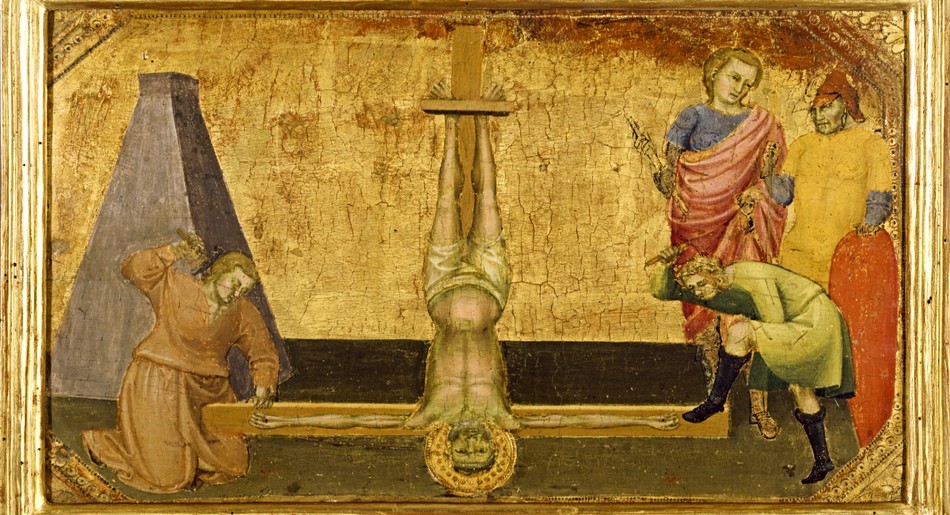An upside-down Latin cross is also known as an inverted cross, Petrine Cross, or Cross of St. Peter. Depending on the intention of using it, the inverted cross is either a sign of Christian faith or of satanic symbolism.
The upside-down cross has a long history (beginning with the Apostle Peter in the 1st Century) and differing meanings in recent times. As its name suggests, an upside-down cross is simply turned so that the crosspiece is closer to the bottom. A person hanging on such a cross would be positioned with their head downwards.
Christian Meaning of an Upside-Down Cross
The upside-down cross in Christianity is linked to the martyrdom of Peter the Apostle. According to Catholic tradition, when Peter was sentenced to death, he requested that his cross be turned upside down because he did not feel worthy of being crucified in the same way as Jesus.
According to tradition and extra-biblical sources, the Apostle Peter was crucified during Nero’s reign on an upside-down cross. In this sense, the inverted cross symbolizes humility in faith because Peter would not be crucified like the Savior, Jesus Christ, was crucified. However, the Bible did not explicitly record these details of Peter’s death. According to GotQuestions.org:
"For centuries, the inverted cross was considered a Christian symbol, based on an ancient tradition that the apostle Peter was crucified upside down. One version of the story says that Peter, facing martyrdom by crucifixion, requested that his cross be inverted because he felt unworthy to die in the same manner as Christ. The upside-down cross, sometimes called the Cross of St. Peter or the Petrine cross thus became a symbol of humility. The inverted cross is sometimes associated with the pope, who Catholics believe can trace his authority back to Peter. Artwork featuring the Petrine cross may contain an overlay of the “keys of heaven,” based on Matthew 16:19."
In John 21:18, Jesus predicted the desperate nature of Peter’s eventual death:
“Very truly I tell you, when you were younger you dressed yourself and went where you wanted; but when you are old you will stretch out your hands, and someone else will dress you and lead you where you do not want to go.”
The phrase Jesus used, “stretch out your hands,” likely involved death by crucifixion as traditional interpretation has affirmed since Tertullian in his On the Prescription of Heretics (200 A.D.). Jerome, who was born nearly 300 years after Peter died, affirmed that Peter was crucified upside down. In Foxe’s Book of Martyrs (1563), John Foxe relied on Jerome’s account:
“Jerome saith that he was crucified, his head being down and his feet upward, himself so requiring, because he was (he said) unworthy to be crucified after the same form and manner as the Lord was.”
The Death of Apostle Peter
According to Christian tradition, Saint Peter was one of the twelve apostles of Jesus and played a significant role in the early Christian community. The story of his crucifixion is linked to the time of Emperor Nero's persecution of Christians in Rome during the first century.
The tradition holds that Peter, facing persecution, attempted to leave Rome to avoid arrest. However, according to legend, as he was leaving the city, he had a vision of Jesus, who was journeying into Rome. In response to this vision, Peter asked Jesus, "Quo Vadis?" which means, "Where are you going?" According to the legend, Jesus replied that he was going to Rome to be crucified again. Taking this as a sign that he should not flee, Peter decided to return to the city to face his fate.
Peter was subsequently arrested and condemned to death by crucifixion. However, he requested to be crucified upside down, considering himself unworthy to die in the same manner as Jesus. The upside-down crucifixion is regarded as a symbol of humility and self-sacrifice.
Why was Peter Crucified Upside Down?
Peter's execution was ordered by the Roman Emperor Nero, who blamed the city's Christians for a terrible fire that had ravaged Rome. Peter requested to be crucified upside down, as he felt unworthy to die in the exact same manner as Christ.
Because the Roman Catholic Church views each pope as a successor of St. Peter, the inverted cross is commonly connected with popes.
The distinction between a Latin cross and a crucifix is also worth noting. A crucifix is a Latin cross with a figure of Jesus on it. An inverted crucifix is always considered disrespectful, inverting the meaning of the cross, whereas a simple inverted cross is not. Still, an inverted cross is sometimes intended as satanic.
The Inverted (Upside Down) Cross and the Occult
In the last half-century, it has been common for the upside-down cross to be employed as a symbol of atheism, humanism, and the occult. Several black metal bands use an inverted cross to show their devotion to Satan. Upside-down crosses appear in horror movies such as The Omen and The Conjuring as a signal of demonic activity. The symbol has been used in tattoos, on pendants, and on t-shirts. Sometimes, it is joined with messages such as “Believe in Yourself,” “There Is No God,” or “Black Mass.”
In these contexts, the obvious intent of the inverted cross is to express an antagonism to Christianity. Turning the cross upside down becomes a means of rejecting the truth of Christ and mocking His sacrifice.
An inverted pentagram is a more common symbol attached to the Church of Satan and Satanism, but an inverted cross is also used, such as in the Satanic Temple’s ceremony unveiling the Baphomet statue.
In popular culture, such as music and movies, the upside-down cross can mean anti-Christian and Satanist sentiments or rebellion against social and political power in general. In Hollywood films like Rosemary’s Baby and The Conjuring, upside-down crosses are associated with demonic activity and overall evilness to creep the audience out viscerally.
The symbolic nature of the upside-down cross is best determined by its context. When the symbol is used in a church setting, it is most likely a reference to Peter and the manner of his death.
In secular culture, the inverted cross is usually an anti-Christian symbol. In our fallen world, righteousness is often mocked, and what is good and pure is twisted by the “god of this age” (2 Corinthians 4:4).
Sources
- Catholic.com, “The Upside Down Cross: Satanic or Symbolic.” Hector Molina, 2014.
- BibleHub.com, Ellicott’s Commentary for English Readers, John 21:18.
- ThoughtCatalog.com, “Here’s What an Upside Down Cross Really Means.” Erin Cossetta, 2018.
- BBC.com, “Decoding the symbols on Satan’s statue.” James Morgan, 2015.
Photo Credit: Public Domain/ Don Marcello Massarenti




